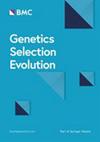Effect of using preselected markers from imputed whole-genome sequence for genomic prediction in Angus cattle
IF 3.1
1区 农林科学
Q1 AGRICULTURE, DAIRY & ANIMAL SCIENCE
引用次数: 0
Abstract
The advent of next-generation sequencing enables the opportunity to use denser marker tools, up to whole-genome sequences (WGS), for genomic prediction in livestock. Improvement in genomic prediction (GP) accuracy from using WGS has been observed in simulation studies. In contrast, such advantage has found to be inconsistent once implemented in practice. The benefit of WGS appears to be from markers that are significant for the trait of interest. Thus, the main objective of this study was to investigate the predictive ability of adding preselected markers to the standard-industry 50k genotype for GP of economically important traits in Angus cattle, namely, birth weight (BW), scrotal circumference (SC), carcass weight (CWT) and carcass intramuscular fat (CIMF). Animals were genotyped with either commercial or customised SNP-genotyping arrays; then, the genotypes were imputed to WGS. The 50k genotype was used as the control group. Informative markers associated with the desired traits were extracted from WGS, then were added to the 50k genotype. Several methods were chosen to select different sets of informative markers, including LD-based pruning, top SNP from a genome-wide association study (GWAS), functional annotation based on Gene Ontology, cattle QTL database, and sequence annotation. In total, eight different sets of genotypes were investigated. We applied different statistical models to predict genomic breeding values, including GBLUP, BayesR, and BayesRC, and two-GRM GBLUP constructed separately from the 50k and the preselected genotype set. Heritability (h2) estimates were similarly calculated using different sets of genotypes and statistical methods across all traits. The log-likelihood ratio values revealed that two-GRM GBLUP was more suitable than the single-GRM GBLUP. There was no significant difference in accuracy and bias among the different sets of genotypes compared to the control group or the statistical methods, except for BW. For BW, the Bayesian models slightly outperformed GBLUP. The findings suggest that potential improvements may be achieved by using preselected SNPs from the GWAS, a method that has proven within the population. The performance of preselected markers on GP influenced by several factors, including population structure, method used to select significant markers, and genetic architecture of traits.安格斯牛全基因组序列预选标记对基因组预测的影响
下一代测序技术的出现,使得使用更密集的标记工具,甚至是全基因组序列(WGS),对牲畜进行基因组预测成为可能。在模拟研究中观察到使用WGS可以提高基因组预测(GP)的准确性。相比之下,这种优势一旦在实践中实施,就会发现不一致。WGS的优势似乎来自于对感兴趣性状有重要意义的标记。因此,本研究的主要目的是研究在标准工业50k基因型中添加预选标记对安格斯牛重要经济性状GP的预测能力,即初生重(BW)、阴囊围(SC)、胴体重(CWT)和胴体肌内脂肪(CIMF)。用商业或定制的snp基因分型阵列对动物进行基因分型;然后,将基因型导入WGS。以50k基因型为对照组。从WGS中提取与所需性状相关的信息标记,然后添加到50k基因型中。选择了几种方法来选择不同的信息标记集,包括基于ld的修剪,来自全基因组关联研究(GWAS)的顶部SNP,基于基因本体的功能注释,牛QTL数据库和序列注释。共研究了8组不同的基因型。采用GBLUP、BayesR和BayesRC等不同的统计模型预测基因组育种值,并分别从50k和预选基因型集构建双grm GBLUP。遗传力(h2)估计值同样使用不同的基因型集和所有性状的统计方法计算。对数似然比值显示,双grm GBLUP比单grm GBLUP更适合。除体重外,不同基因型组的准确性和偏倚与对照组或统计学方法相比均无显著差异。对于BW,贝叶斯模型的表现略优于GBLUP模型。研究结果表明,使用来自GWAS的预选snp可以实现潜在的改进,这是一种在人群中得到证实的方法。群体结构、显著性标记选择方法和性状遗传结构等因素对遗传预选标记在GP上的表现有影响。
本文章由计算机程序翻译,如有差异,请以英文原文为准。
求助全文
约1分钟内获得全文
求助全文
来源期刊

Genetics Selection Evolution
生物-奶制品与动物科学
CiteScore
6.50
自引率
9.80%
发文量
74
审稿时长
1 months
期刊介绍:
Genetics Selection Evolution invites basic, applied and methodological content that will aid the current understanding and the utilization of genetic variability in domestic animal species. Although the focus is on domestic animal species, research on other species is invited if it contributes to the understanding of the use of genetic variability in domestic animals. Genetics Selection Evolution publishes results from all levels of study, from the gene to the quantitative trait, from the individual to the population, the breed or the species. Contributions concerning both the biological approach, from molecular genetics to quantitative genetics, as well as the mathematical approach, from population genetics to statistics, are welcome. Specific areas of interest include but are not limited to: gene and QTL identification, mapping and characterization, analysis of new phenotypes, high-throughput SNP data analysis, functional genomics, cytogenetics, genetic diversity of populations and breeds, genetic evaluation, applied and experimental selection, genomic selection, selection efficiency, and statistical methodology for the genetic analysis of phenotypes with quantitative and mixed inheritance.
 求助内容:
求助内容: 应助结果提醒方式:
应助结果提醒方式:


